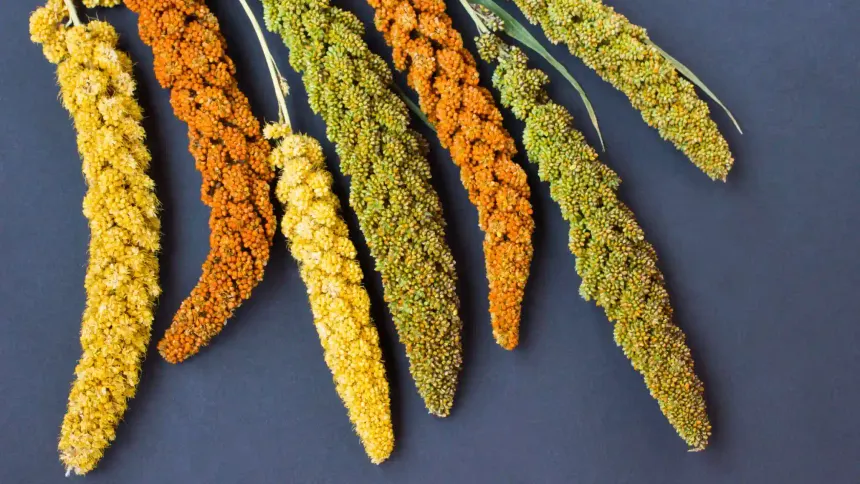Share this Article

Millet Farming in Nepal: An Overview
Millet is a staple crop in Nepal, especially in the hilly and mountainous regions. It thrives in areas with less fertile soil and limited water availability, making it a resilient crop suitable for Nepal’s varied topography. Among the different types of millet grown, finger millet (locally known as "kodo") and foxtail millet (referred to as "kakro" in Nepali) are the most commonly cultivated. Millet is highly valued for its nutritional benefits, including its high protein content, fiber, and important minerals like calcium and iron. It is a primary food source, particularly in rural areas, and is used in a wide variety of traditional Nepali dishes.
Steps for Growing Millet in Nepal
Land Preparation
The first step in millet cultivation is proper land preparation. In the hilly regions of Nepal, farmers typically rely on traditional methods to prepare the land. Plowing is the primary activity, which involves breaking up the soil to ensure it is loose enough for the millet seeds to be planted. Farmers often use animal-drawn plows, although some may use modern machines where available. In terraced fields, which are common in mountainous areas, careful soil management is crucial to prevent erosion and maintain soil fertility. Terracing helps to create flat plots, which can store water more effectively and provide stability for the millet plants.
Seed Selection
For successful millet cultivation, the selection of healthy and high-quality seeds is important. Farmers often save seeds from the previous harvest to sow in the next planting season, although they may also purchase seeds from agricultural suppliers or local markets. Finger millet, for example, requires well-maintained seeds that are free from disease and pests. Farmers usually choose seeds that are adapted to the local environment, ensuring the crops are resilient to local weather conditions, pests, and diseases.
Sowing
The sowing process typically begins at the onset of the rainy season, around June or July, when the weather is suitable for the growth of millet. This period aligns with the monsoon rains, which are crucial for millet cultivation. Millet seeds are usually sown by hand, either by broadcasting them evenly across the field or by placing them in rows, with spacing of about 15 to 20 cm between each plant. For foxtail millet, the rows are generally wider apart to allow for better growth. The depth of sowing is shallow, with the seeds being planted 2 to 4 cm deep to avoid the risk of seed rot, as millet is more prone to disease in overly moist conditions.
Irrigation and Water Management
Millet is known for its drought-resistant qualities, which make it a preferred crop in regions where water is scarce. However, in areas with unpredictable rainfall or during dry spells, some level of irrigation may be necessary to support the millet's growth. While millet can grow with minimal water compared to other crops like rice or maize, controlled irrigation helps to ensure that the crop receives adequate moisture during critical stages. In certain regions of Nepal, where rainfall is irregular, farmers may rely on small-scale irrigation systems, such as drip irrigation or sprinklers, to supplement natural rainfall and avoid crop failure.
Weeding and Crop Maintenance
As millet grows, regular weeding is necessary to ensure that unwanted plants do not compete with the crop for nutrients, water, and sunlight. Farmers typically weed the fields by hand or use simple tools to remove weeds. In some areas, organic fertilizers like compost or manure are applied to improve soil fertility and promote healthy growth. Millet requires minimal care during its growth stages, but consistent weeding and attention to soil health are crucial for maximizing yields. In areas with a more intensive focus on millet production, some farmers might also apply organic or minimal chemical fertilizers to ensure strong and healthy plants.
Pest and Disease Management
Although millet is relatively resistant to pests and diseases, certain challenges can arise during its cultivation. Farmers must be vigilant about potential pests, including birds, rodents, and insects, which can damage the crop. In some areas, birds may be a significant threat to millet fields, especially during the ripening stage. To counter this, farmers may use traditional methods such as scarecrows, netting, or homemade deterrents. If pest or disease issues become more severe, organic pesticides or herbal remedies might be employed. Overall, pest management in millet farming in Nepal tends to rely heavily on traditional practices and community-based solutions.
Harvesting
The timing of harvesting millet is essential to ensure that the grains are fully matured and the plants are dry enough for storage. Millet is typically harvested between October and December, depending on the specific variety and regional climate conditions. Farmers wait for the millet plants to turn a golden-brown color, signaling that the grains are ready to be collected. The plants are generally cut by hand using sickles or knives, as millet has a dense head of seeds that requires careful handling. Harvesting by hand is a labor-intensive process, but it is essential for preserving the quality of the grain.
Post-Harvest Processing
Once harvested, the millet must go through several steps to prepare it for consumption or storage. The first step is threshing, which involves separating the millet grains from the stalks. This is typically done manually by beating the stalks or using mechanical threshers where available. After threshing, the millet is cleaned to remove any dirt, dust, or damaged grains. Drying is another crucial step, as excess moisture in the grains can lead to spoilage. Millet grains are spread out under the sun for several days until they are sufficiently dry. Finally, once fully dried, the grains are stored in sacks or containers in a cool, dry location to preserve their quality.
Milling and Consumption
Millet can be consumed in various forms, and the processing depends on the intended use. Milling is the process of grinding the millet grains into flour, which is commonly used to make traditional Nepali foods such as roti (flatbread), bhat (millet porridge), or pancakes. In rural areas, milling is often done at home using manual mills or, in more developed areas, at local milling facilities. Millet flour is known for its nutty flavor and high nutritional content, making it an excellent choice for both everyday meals and specialized diets.
Alternatively, cooked millet grains are often used in soups or stews, and roasted millet is sometimes eaten as a snack. Additionally, raksi, a traditional Nepali alcoholic beverage, is often brewed from millet in some regions.
Challenges and Solutions in Millet Farming
While millet farming remains a crucial part of Nepal's agricultural economy, it faces several challenges. Climate change has led to unpredictable rainfall patterns, making it difficult to determine the ideal planting times. To address this, farmers have begun adapting their practices by diversifying crops, implementing water-conservation techniques, and experimenting with new varieties of millet that are more resilient to changing climates. Market access is another challenge, as many farmers struggle to sell their millet, leading to potential post-harvest losses. Improving transportation infrastructure and access to markets could help boost millet's economic value.
Additionally, mechanization remains limited in rural Nepal, where most millet farming still relies on manual labor. Introducing affordable farming technologies could help reduce the burden on farmers, increase efficiency, and ensure higher yields. However, much of this will depend on the availability of government support, agricultural extension services, and local initiatives to improve the millet production process.
Millet is a highly nutritious grain that provides a variety of health benefits. It has been consumed for thousands of years in many parts of the world, including Nepal, due to its versatility and health-promoting properties. Here are some key benefits of millet:
Rich in Nutrients
Millet is packed with a range of essential nutrients that contribute to overall health. One of its key features is its high protein content. Unlike many other grains, millet provides a good amount of plant-based protein, which is beneficial for muscle repair, growth, and overall bodily functions. For vegetarians and vegans, millet is an excellent protein alternative to animal-based sources.
In addition to protein, millet is also rich in dietary fiber, which plays a significant role in maintaining digestive health. Fiber helps promote regular bowel movements, prevents constipation, and can assist with weight management by creating a feeling of fullness. This fiber also contributes to better heart health by reducing cholesterol levels and improving blood sugar control.
Millet is also packed with important minerals such as magnesium, calcium, phosphorus, and iron. Magnesium is vital for bone health, muscle function, and heart health. Iron supports the production of red blood cells, while calcium strengthens bones and teeth. The combination of these minerals helps maintain a healthy body, supporting vital processes such as energy production, bone density, and immune function.
Gluten-Free
One of the standout benefits of millet is that it is naturally gluten-free. This makes it a great option for individuals who suffer from celiac disease or those who have a gluten sensitivity or intolerance. People who are avoiding gluten for health reasons can safely incorporate millet into their diet without worrying about triggering digestive issues or allergic reactions. Given the increasing number of people opting for a gluten-free diet, millet provides a highly nutritious and tasty alternative to other grains like wheat and barley, which contain gluten.
Helps in Managing Blood Sugar
Millet has a low glycemic index (GI), which means that it causes a slower rise in blood sugar levels compared to high-GI foods like white rice or bread. This makes millet an excellent food choice for diabetics or people looking to manage their blood sugar levels more effectively. The slow release of glucose into the bloodstream helps prevent spikes and crashes in blood sugar, promoting stable energy levels throughout the day.
Furthermore, millet is rich in magnesium, a mineral that has been shown to improve insulin sensitivity and help regulate blood sugar levels. By improving the body’s ability to use insulin more efficiently, millet can contribute to better diabetes management and may lower the risk of developing Type 2 diabetes in the long run.
Supports Heart Health
Consuming millet regularly can benefit cardiovascular health due to its impressive nutrient profile. Magnesium, a key mineral found in millet, helps lower blood pressure, which is essential for preventing conditions like hypertension (high blood pressure) that can lead to heart disease and stroke. Magnesium helps to relax blood vessels, making it easier for blood to flow, which reduces strain on the heart.
Millet’s fiber content is also beneficial for heart health. Fiber helps reduce LDL cholesterol (the “bad” cholesterol) and can increase HDL cholesterol (the “good” cholesterol). This can help lower the risk of heart disease and stroke by promoting healthier lipid levels in the blood. Additionally, millet contains antioxidants, which help reduce oxidative stress in the body and prevent the buildup of plaque in arteries, further supporting cardiovascular health.
Supports Digestion
Millet is highly effective in promoting digestive health due to its high fiber content. Fiber aids in digestion by adding bulk to the stool, which helps prevent constipation and encourages regular bowel movements. Millet’s fiber also acts as a prebiotic, feeding the beneficial bacteria in the gut, which is crucial for maintaining a balanced microbiome. A healthy gut microbiome is linked to better digestion, improved immune function, and reduced inflammation in the digestive tract.
Moreover, millet is easy to digest, making it an excellent choice for people with sensitive stomachs or digestive issues like irritable bowel syndrome (IBS). Its gentleness on the digestive system allows it to be consumed without causing irritation, making it a suitable food for people of all ages.
Weight Management
Due to its high fiber and protein content, millet is an excellent food choice for weight management. The fiber helps to slow down the digestion process and provides a sense of fullness, which can reduce overall calorie intake. When you feel fuller for longer, you’re less likely to snack between meals or overeat during meals, which can contribute to weight loss or weight maintenance.
The complex carbohydrates in millet provide a steady release of energy, avoiding the energy crashes often associated with consuming refined grains and sugary foods. This sustained energy can help manage cravings and regulate appetite, making millet a great addition to a balanced weight-loss diet.
Improves Skin and Hair Health
Millet is rich in several B-vitamins, such as niacin (B3), riboflavin (B2), and B6, which are essential for maintaining healthy skin and hair. These vitamins play a crucial role in the production of collagen, a protein that helps maintain the skin's elasticity and prevent premature aging. Collagen is also vital for wound healing and skin repair, which is why a diet rich in B-vitamins can help improve the appearance of the skin.
Additionally, zinc, found in millet, supports hair growth and contributes to overall scalp health. Zinc helps balance oil production in the scalp, prevents dandruff, and can help reduce the occurrence of skin conditions like acne and eczema.
Good for Bone Health
Millet’s high content of calcium, magnesium, and phosphorus makes it an excellent choice for maintaining strong bones. Calcium and phosphorus work together to build and strengthen the bone structure, while magnesium helps in the absorption of calcium and supports bone mineralization. Regular consumption of millet can help maintain bone density and reduce the risk of bone-related conditions, such as osteoporosis, especially in older adults.
Detoxifies the Body
Millet contains a variety of antioxidants that support the body’s natural detoxification processes. These antioxidants help neutralize free radicals and remove toxins that accumulate from environmental exposure, stress, or a poor diet. As a result, millet contributes to liver and kidney health, two of the body’s primary detoxifying organs. By supporting the liver’s detox function, millet can help improve overall health and reduce the burden on other organs that process waste and toxins.
Beneficial for Pregnancy and Lactation
Millet is a valuable food for pregnant and lactating women due to its rich nutrient profile. It provides important vitamins and minerals, including folic acid, which is essential for fetal development and preventing neural tube defects during pregnancy. Additionally, iron helps prevent anemia, ensuring that both the mother and baby receive an adequate supply of oxygen. The calcium and magnesium content in millet support healthy bone development for the baby and prevent muscle cramps and fatigue in the mother. Millet’s digestibility and nutrient density make it an ideal choice for women during this important phase of life.
Improves Mental Health
Millet is also a good source of tryptophan, an amino acid that is converted into serotonin in the brain. Serotonin is a neurotransmitter that plays a key role in mood regulation, helping to combat feelings of stress, anxiety, and depression. By boosting serotonin levels, millet can contribute to a more balanced mood and improved mental well-being. This makes millet a great addition to the diet for those looking to naturally support emotional health and reduce the symptoms of anxiety or depression.
Millet is a versatile grain that can be used to make a wide range of food products, from staple foods to beverages. It’s especially popular in many parts of Asia, Africa, and the Middle East. Below is a list of products that can be made from millet, including both food and alcoholic beverages.
Millet Flour
Millet flour is one of the most common products made from millet. By grinding millet grains into a fine powder, millet flour becomes a versatile ingredient in cooking and baking. It’s particularly useful for individuals who need or prefer gluten-free options. Millet flour can be used to make gluten-free breads, pancakes, muffins, and cookies. It can also be mixed with other flours to create pasta, noodles, and flatbreads. Additionally, millet flour can be used to prepare porridges, which are commonly eaten for breakfast or as a light meal.
Millet Porridge
Millet porridge is another popular and traditional product made from millet. To prepare this dish, millet grains are boiled with water or milk to create a creamy, comforting texture. In many cultures, particularly in Nepal and other South Asian countries, millet porridge is a staple breakfast dish. It’s often sweetened with sugar, jaggery, or honey, and can be topped with fruits, nuts, or yogurt for added flavor and nutrition. Millet porridge is not only delicious but also an excellent source of fiber, vitamins, and minerals, making it a nourishing choice for the start of the day.
Millet Rice
Millet can also be cooked in a way that mimics rice. When millet is boiled in water or broth, it forms light, fluffy grains that resemble rice in texture. Millet rice can be served as a side dish with curries, stews, or vegetables. It’s a nutritious and gluten-free alternative to traditional white rice, offering a wealth of fiber, protein, and minerals. Millet rice can also be used as a base for pilafs or salads, making it a versatile option for a wide range of dishes.
Millet Snacks
Millet can be transformed into a variety of delicious snacks. Some of the most popular millet-based snacks include roasted millet, which is crunchy and often enjoyed as a simple snack with added spices or salt. Millet can also be used to create energy bars, where roasted millet is mixed with ingredients like nuts, seeds, dried fruits, and honey. Additionally, millet chips and crackers made from millet flour are a healthier alternative to conventional snacks. These snacks are nutrient-dense and provide a satisfying crunch without the guilt of processed foods.
Alcoholic Beverages from Millet
Millet is widely used in the production of both traditional and modern alcoholic beverages. Many cultures around the world use millet to brew drinks, some of which have significant historical and cultural importance.
Raksi (Nepali Millet Alcohol)
One of the most popular alcoholic drinks made from millet is raksi, a traditional spirit in Nepal. Raksi is typically made from finger millet (kodo) and involves a fermentation and distillation process. The millet is boiled, fermented, and then distilled to produce a strong, clear alcohol. The drink has an earthy flavor and is often consumed during festivals, rituals, and celebrations in Nepal. While raksi can be made from other grains, millet is the preferred base due to its unique properties.
Millet-based Vinegar
Millet can also be used to produce vinegar through fermentation. The process is similar to the production of rice or apple cider vinegar. First, the millet is fermented to produce alcohol, and then it undergoes a second fermentation process to convert the alcohol into acetic acid, which gives vinegar its tangy taste. Millet vinegar is used in a variety of culinary applications, such as salad dressings, marinades, and pickling. Its mild and slightly sweet flavor makes it a great alternative to other vinegars.
Millet Flour-based Beer
In modern times, millet is increasingly used as a base ingredient for brewing gluten-free beers. These beers are brewed specifically for individuals who cannot consume barley due to gluten intolerance or celiac disease. By using millet flour, brewers can create a beer that offers a similar experience to traditional beers, but without the gluten. Millet-based beers often have a slightly nutty, earthy flavor and can be a great option for those seeking gluten-free alcoholic drinks.
Conclusion
Millet is an incredibly versatile grain that can be used to make a wide range of products, both food and drink. From flours and porridges to snacks and alcoholic beverages, millet has been a staple in many cultures for centuries. Whether you’re enjoying a bowl of millet porridge for breakfast, sipping on a traditional millet-based drink like raksi or incorporating millet flour into your baked goods, this nutritious grain offers countless culinary possibilities. Its ability to be used in both non-alcoholic and alcoholic products makes it a unique and valuable ingredient in global diets.
Categories:
Education
Tags:
Millets
,
HealthyEating
,
WholeGrains
,
MilletPower







